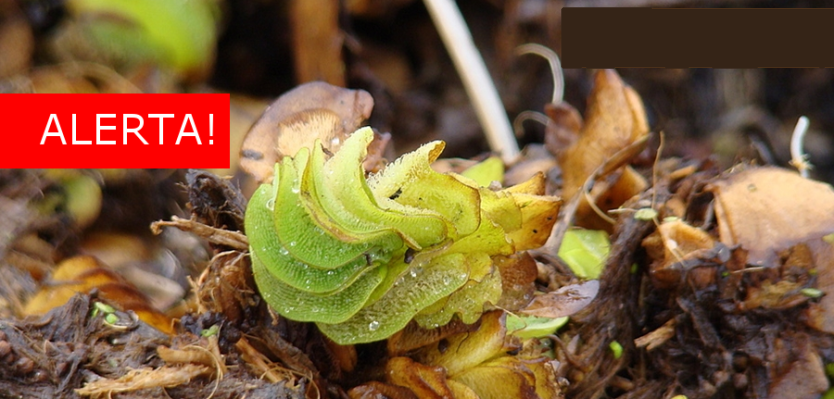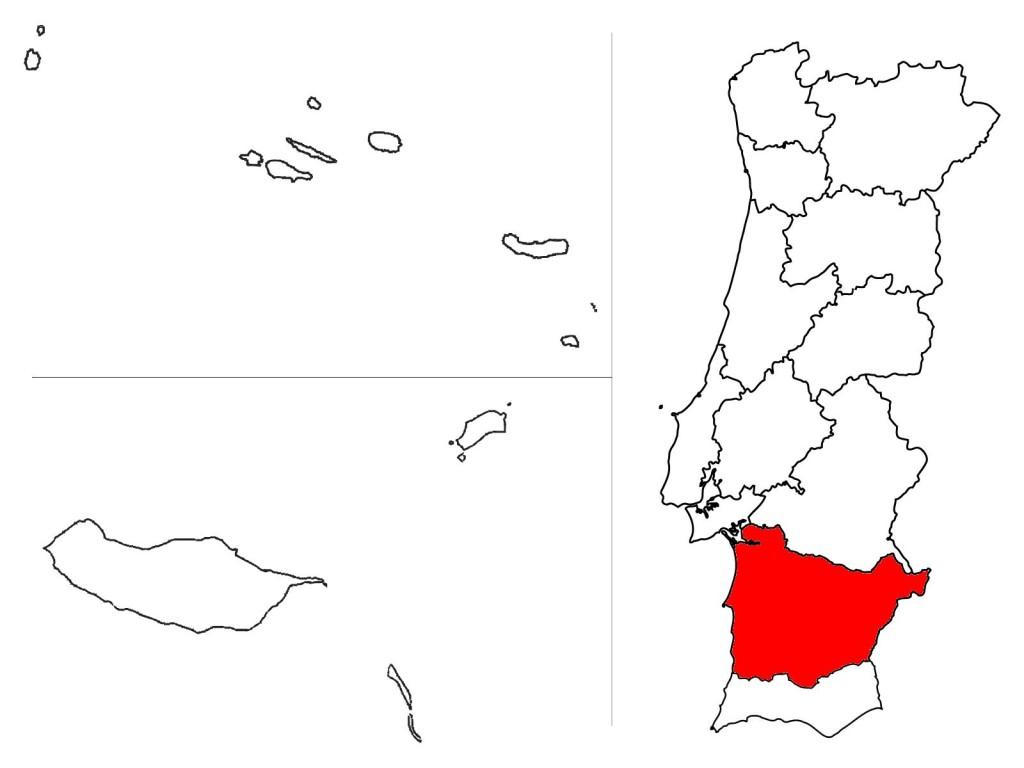
Floating aquatic fern with 3 leaves at each node (2 floating, egg-shaped, light green, hair-covered leaves, and one brwon submerged leaf, color that resembles a root).
Scientific name: Salvinia molesta D.S.Mitch.
Common name: kariba weed, African pyle, aquarium water moss, aquarium watermoss, aquarium water-moss, Australian azolla, butterfly fern, cats tongue, giant azolla, giant salvinia, kariba-weed, koi kandy, salvinia, velvet weed, water fern, water spangles, watermoss
Family: Salviniaceae
Status in Portugal: Casual species, but it is starting to disperse – check our alert! In a prevention logic, it is already listed as an invasive species in Decree-Law nº 92/2019, 10th July. It is Included in the list of species of concern of the European Union, by Regulation (EU) no. 1143/2014 of the European Parliament and of the Council of 22 October 2014).
Risk Assessment Score: 25 | Value obtained according to a protocol adapted from the Australian Weed Risk Assessment (Pheloung et al. 1999), by Morais et al. (2017), according to which values above 13 mean that the species has risk of having invasive behavior in the Portuguese territory | Updated on 30/09/2017.
Synonymy: Salvinia adnata Desv.
Last update: 24/10/2017
Help us map this species on our citizen-science platform
How to recognize it
Floating aquatic fern with 3 leaves at each node (2 floating, egg-shaped, light green, covered with hairs and one submerged, brown like a root).
Leaves: 3 at each node: 2 floating, ovate, light green, 2.5-6 cm, covered with hairs; 1 submerged, brown, looking like a root. Single plants have smaller, oval, above water leaves; when they integrate dense mantles they become robust, the leaves increase and curve until they overlap, with a clear central pleat. The leaves' upper surface is covered by cylindrical papillae, each with four hairs on the tip, which are joined at the end, forming a structure that resembles a small cage or an egg beater. This structure traps small air bubbles, helping the plant to float and repel water from the upper side of the leaves, which keeps them in the correct position.
Sporocarps: adult plant produces sporocarps containing infertile spores.
Similar species
A similar species is Salvinia natans (L.) All., but it does not have the characteristic hairs of S. molesta (in the form of a small cage or an egg beater), so it is easily distinguished.
Characteristics that aid invasion
It grows rapidly in nutrient-rich waters, and can double the area in just one week. It forms dense mats of tightly packed leaves that can completely cover the water surface and reach 1 m in thickness. Despite not being able to reproduce sexually, it disperses very easily after vegetative growth and fragmentation. Small fragments can be naturally dispersed by birds and mammals, and they can also be transported accidentally clinging to boats, fishing nets or other artifacts. It can survive on-shore and withstand some drought, having already been observed to proliferate in terrestrial environments with constant humidity, near Victoria Falls in South Africa.
Native distribution area
South America.
Distribution in Portugal
Mainland Portugal (Baixo Alentejo).
For more detailed locations of this species, check the online interactive map. This map is still incomplete – we need your help! Contribute by submitting records of the location of the species where you can find it.
Other places where the species is invasive
South Africa e tropical Africa, tropical Asia, Australia and New Zealand, Melanesia and Polinesia.
Introduction reasons
This species was introduced for ornamental and aquarium use. Several species of Salvinia are on sale in nurseries, but none should be used given the great aggressiveness of the genus.
Preferential invasion environments
Freshwater wetlands, ponds, and streams.
Impacts on ecosystems
In still waters or with slow current, Salvinia molesta can multiply quickly forming dense mats up to 1 m thick. It can completely cover the surface, killing all submerged vegetation and reducing dissolved oxygen in the water, causing the death of aquatic fauna as well. Dead plants release large amounts of nutrients into the water, thus increasing the eutrophication of the water body. It reduces the flow of water, which can lead to flooding. Dense mats of Salvinia molesta can block access by humans and animals (domestic and wild) and prevent the use of boats, fishing nets and even make it impossible to produce hydroelectric power, irrigation systems and flood control. The changes caused in ecosystems by the invasion of Salvinia molesta may also favor the reproduction of disease-carrying mosquitoes.
Controlling an invasive species demands a well-planned management, which includes the determination of the invaded area, identifying the causes of invasion, assessing the impacts, defining the intervention priorities, selecting the adequate control methodologies and their application. Afterwards it is fundamental to monitor the efficiency of the methodologies and recuperation of the intervened area as to perform, whenever necessary, the follow-up control.
The control methodologies used for Salvinia molesta include:
Physical control
Large invaded areas can be harvested mechanically but this can lead to fragmentation and dispersion.
Biological control
In several invaded areas , the use of the insect Cyrtobagous salviniae, which feeds only on Salvinia molesta, was successfully tested, not affecting the native species. The larvae of this small weevil burrow tunnels into the plant's stems, reducing its ability to float and eventually sinking it. In Portugal, biological control of S. molesta is not yet an option.
Chemical control
The herbicides are Diquat (formulated for running water), hexazinone, chlorsulfuron or fluridone.
Visit the webpage How to Control for additional and more detailed information about the correct application of these methodologies.
See more detailed information on Measures and costs for prevention, early detection, rapid eradication and management of this species, according to the technical documents supporting European Regulation No. 1143/2014, perpared by the IUCN (International Union for Conservation of Nature) in collaboriation with the collaboration with IUCN Invasive Species Specialist Group.
Cousens RD, Hussey BMJ, Keighery J, Lloyd SG (2007) Western weeds. Australia, pp. 2.
DiTomaso J, Healy E (2003) Aquatic and riparian">Riparian Weeds of the West. California. pp. 57.
Marchante H, Morais M, Freitas H, Marchante E (2014) Guia Prático para a Identificação de Plantas invasoras">Invasoras em Portugal. Imprensa da Universidade de Coimbra, Coimbra, pp. 176.
Pheloung PC, Williams PA, Halloy SR (1999) A weed risk assessment model for use as a biosecurity tool evaluating plant introductions. Journal of Environmental Management. 57: 239-251.
Pieterse A, Kettunen M, Diouf S, Ndao I, Sarr K et. al. (2003) Effective biological control of Salvinia molesta in the Senegal River by means of the weevil Cyrtobagous salviniae. Ambio. 32 (7): 458-62
Sullivan P, Postle L (2012) Salvinia Biological Control Field Guide. State of New South Wales through Department of Trade and Investment,Regional Infrastructure and Services. ISBN 978 1 74256 252 0 Available: http://www.aabr.org.au/images/stories/resources/ManagementGuides/WeedGui... [Retrieved 27/06/2017].
The Plant List. Salvinia molesta. D.S.Mitch. Disponível: http://www.theplantlist.org/tpl1.1/record/tro-26604303 [Retrieved 15/09/2015].
Weber E (2003) invasive">Invasive plant species of the world: a reference guide to environmental weeds. Reino Unido: CABI, 2003. ISBN 0851996957. 384pp.



